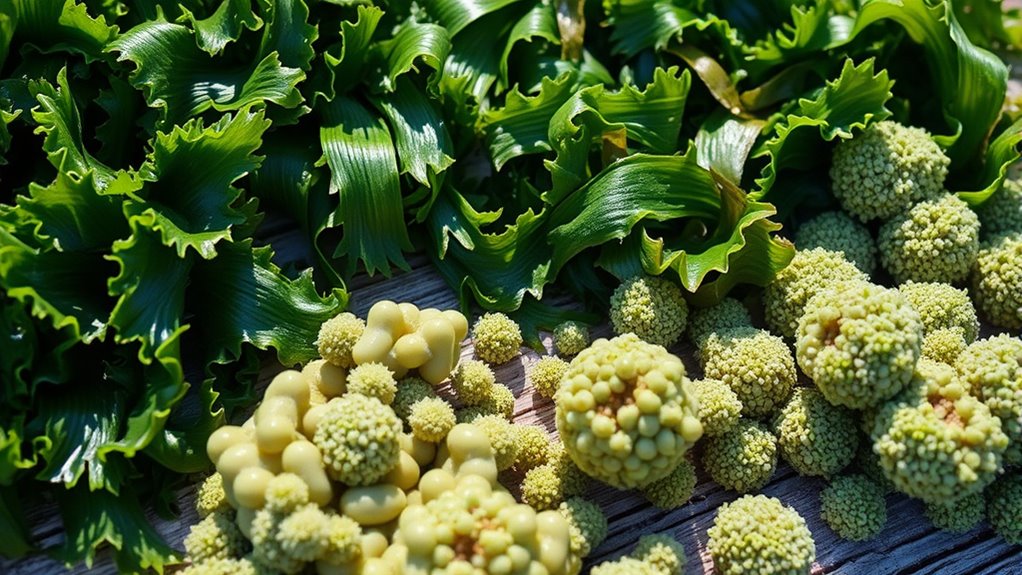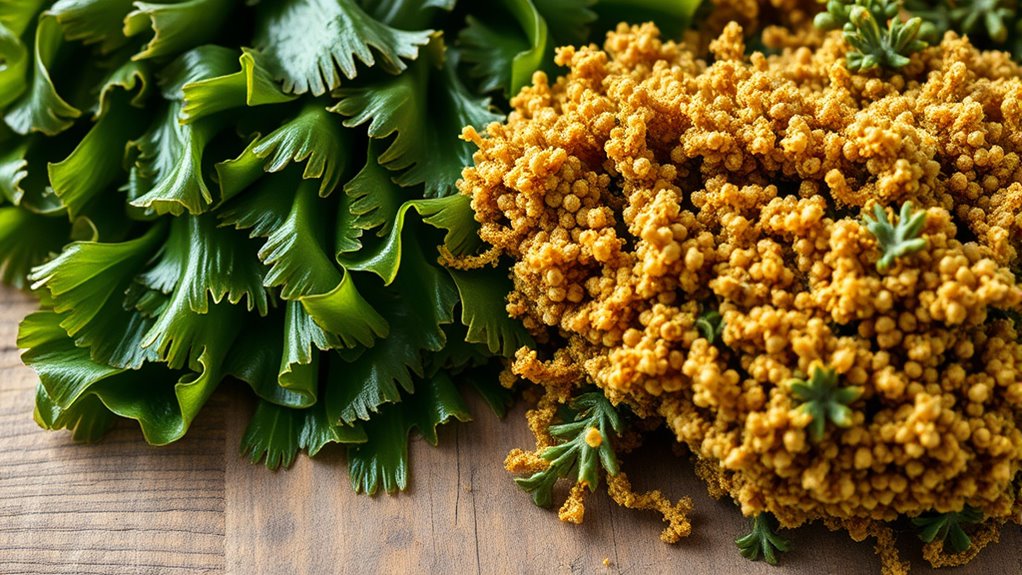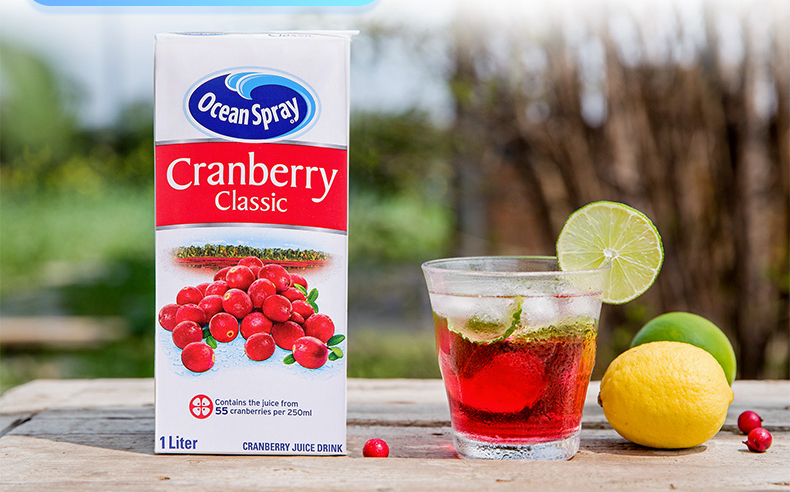Starting with seaweed and sea moss is easy once you understand their benefits and uses. You can forage wild-harvested varieties or choose farmed options, which are sustainable and safe. Use them in soups, smoothies, salads, or as natural thickeners—the options are versatile. Rinse thoroughly and prepare them for dishes to get the most nutrients. As you explore, you’ll discover how these ocean superfoods can enhance your diet and well-being. Keep going to learn even more.
Key Takeaways
- Learn about different types of seaweed and sea moss and their unique nutritional benefits.
- Understand sustainable harvesting and farming techniques to support ocean health.
- Discover simple ways to incorporate seaweed and sea moss into daily meals and recipes.
- Properly prepare and clean these superfoods to maximize flavor and health benefits.
- Explore their environmental advantages and how they contribute to a balanced, eco-friendly diet.

If you’re new to the world of marine superfoods, seaweed and sea moss are excellent places to start. These nutrient-rich foods have been consumed for centuries across various cultures, and they’re gaining popularity for their health benefits and culinary versatility. When it comes to harvesting techniques, it’s important to understand that sustainable practices are key. Wild-harvested seaweed is typically gathered by hand during low tide, ensuring minimal environmental impact. Harvester’s use scissors or knives to carefully cut the seaweed at the base, avoiding damage to the holdfasts that allow the seaweed to regrow. This careful approach helps maintain healthy marine ecosystems and ensures a continuous supply of seaweed for future harvests. If you’re interested in cultivating your own supplies, seaweed farming is also an option. It involves growing seaweed on ropes or nets anchored to the ocean floor, which can be done sustainably and with minimal disruption to local habitats.
Once you’ve harvested or purchased fresh seaweed, exploring its culinary uses opens up a world of delicious possibilities. Seaweed can be incorporated into salads, soups, smoothies, and even baked goods. Its natural umami flavor adds depth to dishes without the need for artificial flavorings. You might try adding chopped nori to rice bowls or wrapping sushi rolls with it. Wakame, another popular variety, works well in miso soup or as a salad topping, thanks to its tender texture and mild taste. Dried seaweed can be rehydrated and used as a garnish or ingredient, providing a crunchy texture or subtle saltiness. Sea moss, often sold as a gel or powder, can be blended into smoothies for a nutrient boost or used as a thickening agent in desserts. Incorporating seaweed into your cooking is simple: just rinse fresh varieties thoroughly to remove any sand or debris, then chop or tear into pieces suitable for your recipes. Additionally, understanding the nutritional benefits of seaweed and sea moss can help motivate your culinary exploration and support your health goals.
As you experiment with harvesting techniques and culinary uses, you’ll discover that seaweed and sea moss are versatile ingredients that can enhance your meals and support your health. They’re not only easy to incorporate into everyday dishes but also provide a sustainable way to enjoy the bounty of the ocean. Plus, learning about the different types of seaweed and their specific uses helps you make informed choices, whether you’re sourcing wild-harvested or farmed options. With a little practice, you’ll find that these marine superfoods become an essential part of your kitchen, enriching your diet with their unique flavors and impressive nutritional profile.
Frequently Asked Questions
Can Seaweed and Sea Moss Be Eaten Daily?
Yes, you can eat seaweed and sea moss daily, but moderation is key. They offer great nutritional benefits like iodine, minerals, and antioxidants that support your health. However, be mindful of sustainability concerns, as overharvesting can harm marine ecosystems. Incorporate them into your diet responsibly, balancing their benefits with environmental impact, and consult a healthcare professional if you have thyroid issues or other health conditions.
Are There Any Side Effects From Consuming Seaweed?
Yes, consuming seaweed can cause side effects like allergic reactions in some people, especially if you’re sensitive to iodine or shellfish. Additionally, heavy metal contamination is a concern if you eat large amounts or choose low-quality sources. It’s best to start with small servings, buy from reputable suppliers, and monitor your body’s response to avoid adverse effects.
How Do I Store Seaweed and Sea Moss Properly?
To store seaweed and sea moss properly, keep them in airtight containers to preserve freshness and prevent moisture. For dried varieties, store in a cool, dark place away from sunlight, ensuring they stay dry. If you have fresh seaweed or sea moss, refrigerate them in a sealed container and consume within a few days. Proper storage methods help maintain their quality and maximize shelf life.
Is Seaweed Suitable for People With Thyroid Issues?
If you have thyroid issues, you should be cautious with seaweed because it’s high in iodine, which impacts iodine intake and thyroid health. Too much iodine can worsen certain thyroid conditions, so consult your healthcare provider before including seaweed in your diet. Moderation is key, and they can help determine safe amounts based on your specific health needs.
Can Seaweed and Sea Moss Be Used in Cooking Recipes?
Yes, you can definitely use seaweed and sea moss in cooking recipes. They add unique flavor combinations and boost nutritional benefits, making your dishes more wholesome. Toss seaweed into soups, salads, or stir-fries for a savory umami taste. Sea moss can be blended into smoothies or used as a gel in baking. Get creative and enjoy the health perks while enhancing your meals with these versatile ingredients.
Conclusion
Now that you know the basics, incorporating seaweed or sea moss can boost your health naturally. Imagine adding a spoonful of sea moss to your morning smoothie—like Sarah did, transforming her energy levels and digestion in just weeks. Starting small makes it easy to enjoy their benefits. So, go ahead, experiment with these ocean treasures and see how they can enhance your wellness journey. Plunge in and embrace the sea’s nourishing power!
Ilana has been a vegan for over 10 years. She originally made the switch for health reasons, but soon found herself becoming more and more passionate about the ethical and environmental implications of a vegan lifestyle. Ilana is the author of The Graceful Kitchen, a blog all about veganism. She loves to cook up delicious and nutritious vegan meals, and share her recipes with others who are interested in leading a cruelty-free life. Ilana is also a strong advocate for using whole foods as the foundation of a healthy diet, and believes that going vegan is one of the best ways to achieve this.










